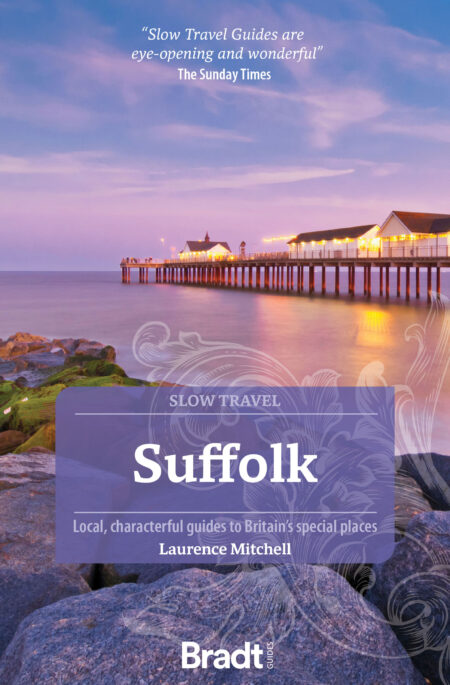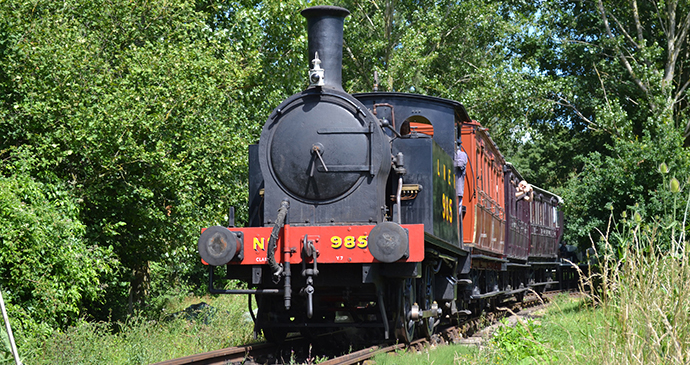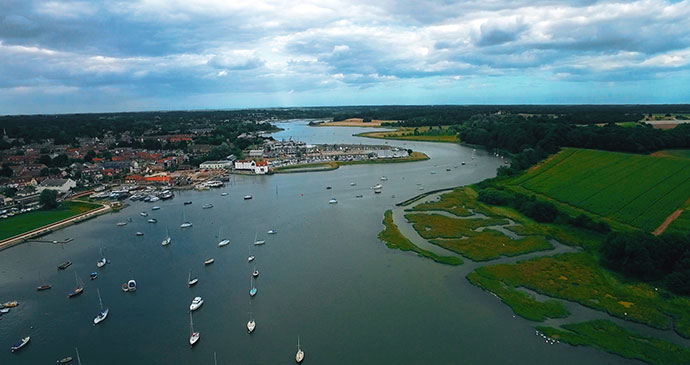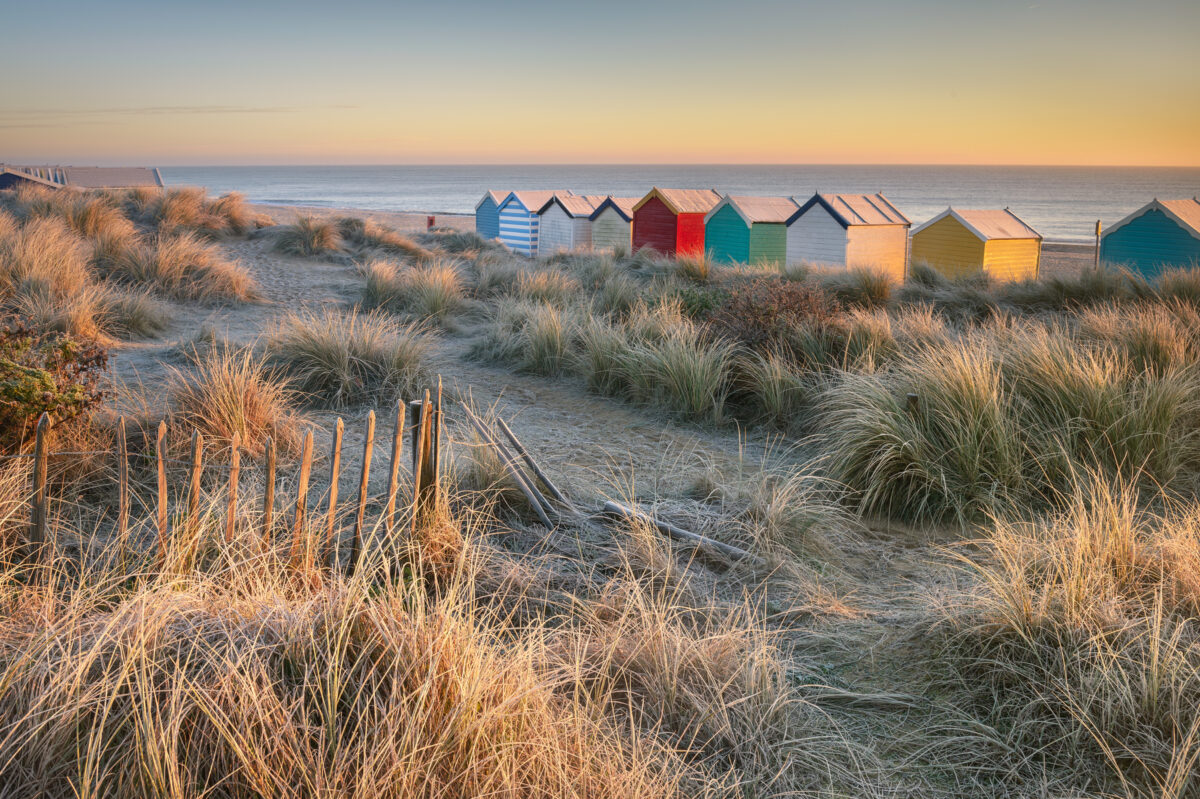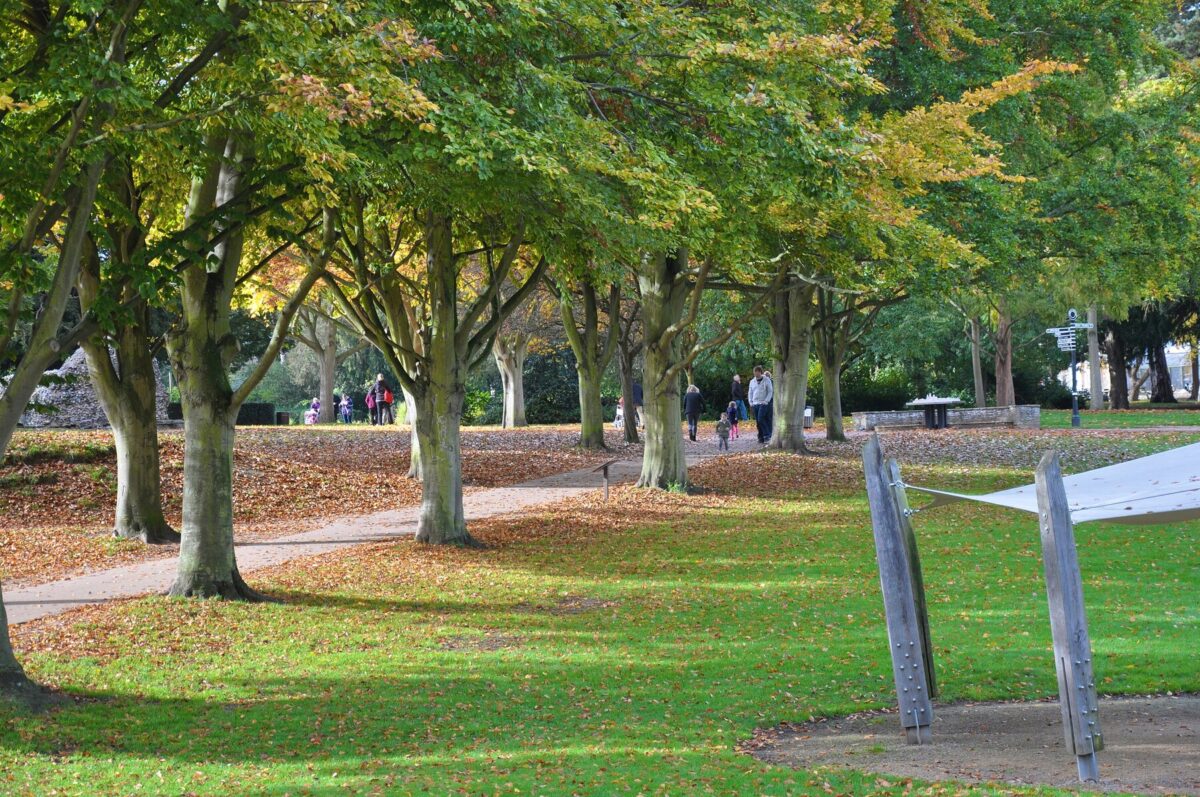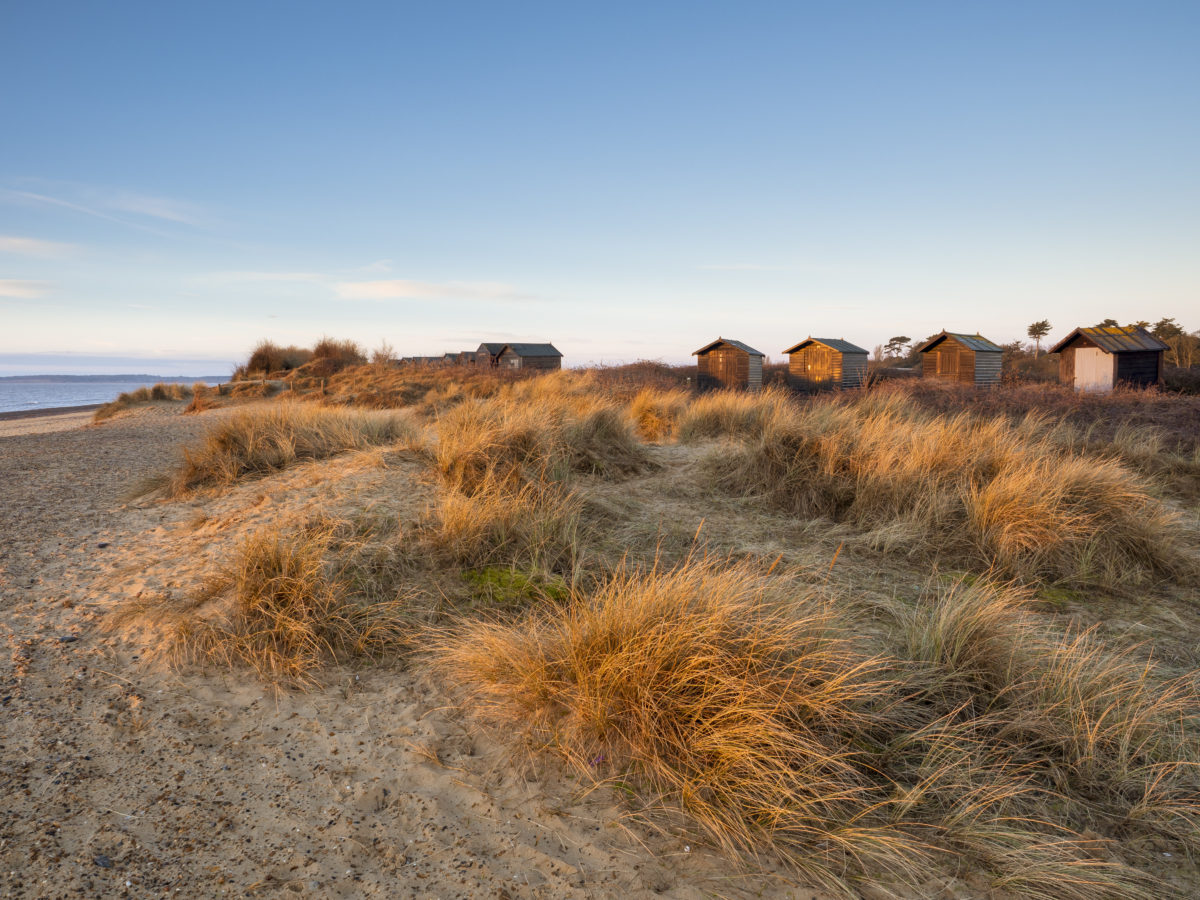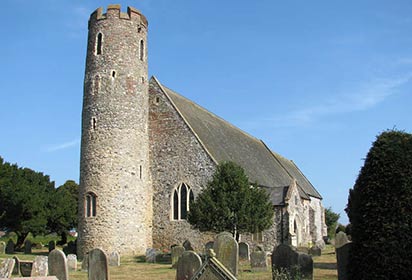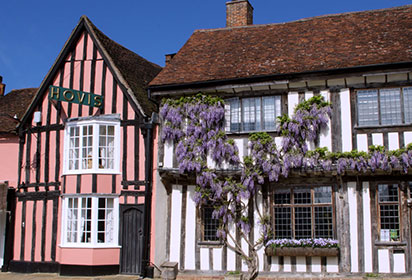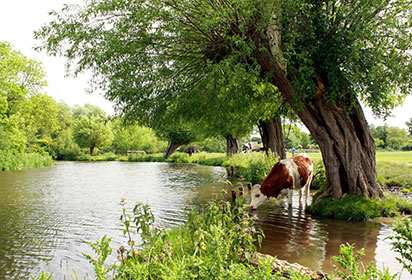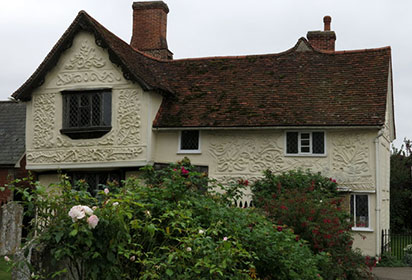Suffolk is ideal for Slow exploration. Cycling, sailing and walking are all good options for exploring its landscapes, discovering the varied wildlife and delving into its rich historic past.
Laurence Mitchell author of Suffolk: The Bradt Guide
Like Norfolk, its northern neighbour, the county of Suffolk was largely bypassed by the Industrial Revolution. This is not to say that Suffolk has little in the way of historical interest – far from it – it is just that most of the county’s really big events tended to take place a long time ago back in medieval times.
The material legacy of the medieval period is still highly visible in the county, especially in beautifully preserved villages like Lavenham where pink-washed, half-timbered houses line the streets. Elsewhere, at towns like Framlingham, you’ll find impressive medieval castles, and it seems that virtually every village in the county comes complete with a green and a charming medieval church.
But Suffolk, despite being chocolate-box–pretty, is no mere museum piece but an active and productive county busy at work with its farming, fishing and market gardening.
As well as having great historical interest, Suffolk is also a wonderful place to spot wildlife, with pockets of ancient woodland and first class bird-watching potential in the coastal marshes at places like the RSPB Minsmere reserve near Dunwich. Many visitors also come for the walking, which is excellent with several long-distance routes running through the county.
The Suffolk Heritage Coast once had several important ports along its length but coastal erosion has resulted in places like Southwold, Walberswick and Aldeburgh having little choice but to reinvent themselves as upmarket holiday resorts. While some might argue that such places belong to a sort of soft-focus 1950s time-warp, the vast majority of visitors who come here really would not want them any other way.
Bradt on Britain – our Slow Travel approach
Bradt’s coverage of Britain’s regions makes ‘Slow Travel’ its focus. To us, Slow Travel means ditching the tourist ticklists – deciding not to try to see ‘too much’ – and instead taking time to get properly under the skin of a special region. You don’t have to travel at a snail’s pace: you just have to allow yourself to savour the moment, appreciate the local differences that create a sense of place, and celebrate its food, people and traditions.
For more information, check out our guide to Suffolk
Food and drink in Suffolk
Suffolk is primarily an agricultural county and it prides itself on the foodstuffs it produces – directly or indirectly – from its fertile soil. As well as the obvious cereal, sugar beet and oilseed rape crops there are plenty of fresh seasonal vegetables to be had from smallholdings throughout the county. Suffolk also has its fair share of orchards and a large number of varieties of apple, pear and plum, some of which are rare and hard to find or absent elsewhere in the country. A good example of this is the sweet black cherry variety found at Polstead. Apple varieties are prolific and a number of Apple Day celebrations are held at several locations throughout the county in October. Fruit can be purchased either directly from the orchard, such as at High House Fruit Farm at Sudbourne near Orford, or at one of the many farmers’ markets held regularly in towns and villages throughout Suffolk.
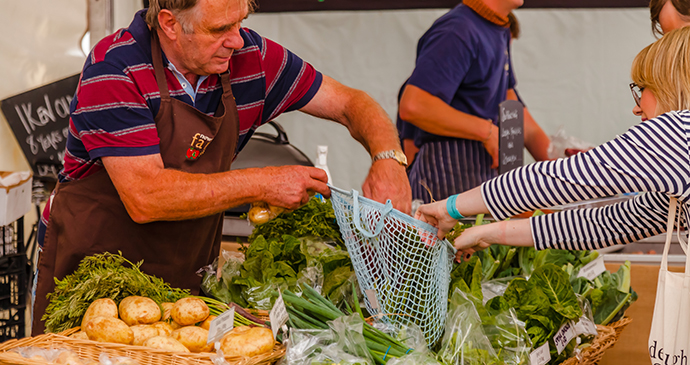
There is plenty of grazing too and the county has a number of rare breed farms that stock specialties like Red Poll cattle. Many of the better pubs and restaurants have locally reared meat on the menu and it can also be bought for home consumption at butchers, delis and farmers’ markets all over Suffolk. There’s also game and venison aplenty available from large estates like Elveden. Good places for food shopping are the Suffolk Food Hall near Ipswich, which as well as meat products has an excellent selection of breads, cheese and fish, and Emmett’s of Peasenhall, a deli and smokehouse that has a variety of smoked meat products that include sweet-cured Suffolk hams and bacon from free-range pigs.
While Lowestoft is not the fishing port it once was, the waters of the North Sea off the Suffolk coast continue to provide plenty of fish. The former ports of Southwold and Aldeburgh still have a small number of fishermen who make their living from the sea. To buy bright-eyed ultra-fresh fish direct from a fisherman’s hut next to the water is a pleasure that outdoes supermarket shopping any day. To eat locally caught fish and chips next to the sea is an even greater delight: the Aldeburgh Fish & Chip Shop is considered by many to be the best in the country … just be aware that its popularity always means that there’s a queue.
Suffolk supping
The county is well known for the beer it produces: Greene King from Bury St Edmunds is pretty ubiquitous, and Adnams from Southwold can be found more or less throughout the county (and even in Norfolk and beyond). Suffolk also boasts a number of smaller-scale breweries like those at St Peter’s in the Waveney Valley, Brandon Brewery in the Brecks and Old Cannon Brewery in Bury St Edmunds.
Hardly surprising considering the number of orchards in the county, it is good to discover that cider – or rather, cyder – is not just a product from the West Country. One fairly large producer in the county is Aspall Hall near Debenham, which makes delicious apple juices too. Last but not least, there’s also Suffolk-produced wine to be savoured. A number of quite select whites are produced from a handful of vineyards in the county, such as those at Wyken near Ixworth and Giffords Hall near Hartest.
Where to stay in Suffolk
For information about accommodation, see our list of the best places to stay in Suffolk.
What to see and do in Suffolk
The Mid-Suffolk Light Railway Museum opened in 1990 after the station closed in 1951 © Roger Silsbury
Central & East Suffolk
This area covers the ‘High Suffolk’ plateau that rises south of the Waveney Valley. Let’s not get too carried away with the words ‘high’ or ‘plateau’ though – as you might expect for East Anglia, it’s pretty modest stuff. ‘High Suffolk’ may be overstating it a bit but compared with the rest of the county it is just that: a rolling plateau of arable farmland interspersed with villages and small market towns.
A hundred years ago, this area was almost entirely devoted to agriculture and most of the land is still used for arable crops, although these days most local inhabitants are involved in pursuits other than farming. Despite the vast seas of golden wheat that turn some of these settlements into virtual islands in August, farming involves a very small workforce these days: agriculture may well be big business, but is no longer a big employer. Nevertheless, the towns and villages of this area retain plenty of connections with the soil, as do the people, and although daily village life may no longer revolve around the changing seasons, it still takes notice of them.
South Suffolk & The Stour Valley
This area covers the southern part of the county that includes the towns of Lavenham and Hadleigh and their hinterland as well as them Suffolk side of the Stour Valley (from East Bergholt and the Stour estuary in the east as far as Clare in the west) that stretches along the Suffolk–Essex border to the south. In the south of the county, the Stour Valley is still very much a rural idyll, as the Stour babbles its way through fields of contented cattle and past improbably perfect-looking villages. A chocolate-box scene as painted by John Constable – and it was … many times over. It is not so much that Constable was a great painter – although he undoubtedly was – but what he painted. Though the healthy character of Constable’s Suffolk has disappeared, the subject matter of many of his works is still easily identifiable almost two centuries later.
This gives all of us a warm, fuzzy sense of continuity and tradition, and delights even those who do not normally have much time for paintings. Most of all, it somehow encapsulates the essence of rural England. The irony is that many who live here among the Stour Valley’s timber-framed splendours are also those that have the most tenuous connections to the area – a classic incomers versus disgruntled locals dilemma. London and the Home Counties are sometimes just a little too close for comfort and the goose that laid the golden egg is in danger of being flattened beneath the wheels of a commuting 4×4. In many cases the commute by car is a short one – just as far as Manningtree railway station, less than an hour from London’s Liverpool Street. In the old days, geese would walk all the way to London from the area. There again, it was always just a one-way trip.
Stylish Woodbridge has a wealth of excellent independent shops and places to eat © thesuffolkcoast.co.uk
Southeast Suffolk
Southeast Suffolk is somewhat of a mixed bag that deals with some of the largest places in the county as well as tiny estuary villages. The various inlets and estuaries that punctuate the coastline further north continue to do so in this part of the county, although they tend to be much larger and wider. The Rivers Deben, Orwell and Stour all flow into the North Sea along this stretch and the sea trade that dwindled centuries ago in the silted-up ports of the northern part of the coast still thrives here.
The Port of Felixstowe is currently the largest container port in the country, which might not suggest very much in the way of Slow credentials but the port is just one aspect of Felixstowe and the town itself has many redeeming features. Ipswich, too, might seem on first inspection to be brash and traffic-blighted, but the town has far more going for it than might immediately be apparent. Woodbridge, on the other hand, has abundant Slow appeal. As for the Shotley Peninsula, if anywhere were to be awarded the clichéd epithet of ‘best kept secret’ then this might be a worthy contender. It’s not a secret of course, just a little unsung.
The Heritage Coast
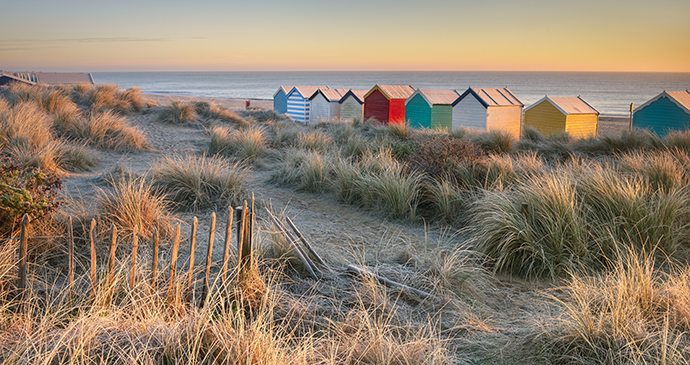
It may be tempting to think that the workaday town of Lowestoft typifies this coastline. This couldn’t be further from the truth, as the port is an exception and, from Kessingland all the way down to Bawdsey, the Suffolk coast is mostly rural and peaceful, with a couple of old-fashioned resorts interspersed by tiny villages up against the shingle. It is not an undiscovered coastline – far from it – but somehow Suffolk’s unhurried, gentle pace of life has managed to persist without too much intrusion from the 21st century. Some things have changed quite dramatically over the past half century, of course, particularly the economy of the region and the incomers who have come to live here, but overall its character has survived without it ever becoming too much of a museum piece.
This coast has always attracted outsiders. The Scottish Art Nouveau architect and designer Charles Rennie Mackintosh came here to paint flowers when his architectural career was in the dumps. Benjamin Britten, having taken leave of his home town of Lowestoft, made his home at Aldeburgh and wrote an opera about a fisherman, Peter Grimes. Southwold and Walberswick have always been popular with BBC television producers, authors and politicians, and you might even catch a glimpse of a vacationing rock star or Hollywood royalty at Aldeburgh’s better hotels and restaurants. There is no doubt about it: the Suffolk coast exudes a certain type of understated glamour – classy and comfortable, like a pair of old but expensive shoes.
Between Lowestoft and Felixstowe, various inlets and estuaries punctuate the coastline. The rivers Blyth, Dunwich, Minsmere, Alde, Ore, Deben, Orwell and Stour all flow into the North Sea along this stretch, and the larger of these once brought trade and prosperity to the wool villages of the Suffolk hinterland. These rivers were once far more important than they are today, and far more navigable too. Look at the River Ore that flows through Framlingham – a mere brook these days – and shake your head in disbelief that stone for building the town’s castle was once shipped here all the way from the coast.
As well as the coast itself, this chapter also covers the immediate hinterland, roughly east of the A12 Lowestoft to Ipswich road. A good chunk of that terrain constitutes what’s known as The Sandlings, which has light sandy soil akin to that of the Brecks in the west of the region. The Sandlings has a similar history to the Brecks too: early settlement by Neolithic peoples thanks to easily workable soil; medieval overgrazing by sheep; widespread gamekeeping and forestry in the first part of the 20th century; arable crops in the second half. Today, it is an area characterised by sandy heaths, forestry plantations and wide fields of grain.
The urban centre, Lowestoft, by far the biggest place along this stretch of coast, gets a mention but is hardly representative of the rest. However, if you are at all interested in Southwold sailors, bedevilled Blythburgh or disappearing Dunwich, or are curious to experience the sensation of ‘orfordness’, then read on. I start by working down the coast north to south, detouring inland as seems appropriate. Away from the comfortable respectability of resorts like Southwold and Aldeburgh are some real oddities. Dunwich, now little more than a pub, café and car park, was one of England’s great ports back in the 12th century. Orford Ness was a top-secret military research site that was firmly off-limits until the National Trust bought it in 1993, while Snape Maltings, now an extensive arts and music complex, was a working maltings until not so very long ago.
The Waveney Valley
Two rivers separate Suffolk from Norfolk, its northern neighbour. In the west, the Little Ouse River forms a natural boundary between the two counties, while in the centre and east the River Waveney defines the border. The Waveney’s source lies between the villages of Redgrave in Suffolk and South Lopham in Norfolk, close to where the Little Ouse also rises.
From its humble origins in Redgrave Fen, the river flows east through the small towns of Diss (Norfolk), Bungay and Beccles (Suffolk) before looping north around Lowestoft to join the River Yare at Breydon Water and eventually go to sea at Great Yarmouth. East of Bungay, the river lies within the boundary of the Broads Authority and the river is connected to Oulton Broad just west of Lowestoft by a manmade channel, Oulton Dyke.The only deviation that the county boundary makes from the river is between Great Yarmouth and Lowestoft, just north of Somerleyton where, instead of continuing north to reach Breydon Water, it veers east through Fritton Lake to reach the North Sea at Hopton-on–Sea. The reason for this anomalous diversion from the natural river boundary is administrative. It is also a relatively recent departure from topographic common sense.
Not that the Waveney forms an impenetrable barrier: the river is more of a conduit than anything, with plenty of bridges spanning it, especially in its western reaches. The Waveney Valley may not be much of a valley in physical terms but it does have a personality all of its own that is distinct from the rest of the county. A sense of cosy isolation characterises the Waveney Valley, as south Norfolk eases into the clay country of north Suffolk.
Here there are fewer big estates, and more commons, ancient hedgerows and moated farmhouses; more meandering tracks that seem to follow every field boundary before ending up nowhere in particular. There has probably been less change over the past 50 years in this region than anywhere else in southern England. Unlike other parts of Suffolk, the area is not a place that tends to lure incomers, downsizers or weekenders.
The Waveney Valley has a different kind of draw. Those that have settled here have generally become more integrated into the existing community. It has long attracted artists, writers and craftsmen and there was a noticeable, if small-scale, invasion of folk escaping the city for something simpler and more wholesome back in the 1970s – they are mostly still here.
A surprising number of artists work from the towns and villages of the valley. Constable and Gainsborough may have immortalised the Stour Valley further south on the Essex border but that just happened to be where they lived.
It might just as easily have been the Waveney Valley. To quote author and pioneer of sustainable living John Seymour: ‘If John Constable had been born at Harleston, instead of at East Bergholt, we would have processions of motor coaches along the Waveney instead of along the Stour.’ As for present-day local artists, perhaps the recently deceased Mary Newcomb (1922–2008) is the most representative for her innocent, yet evocative, vignettes of country life – not exclusively featuring the Waveney Valley but certainly evoking its spirit.
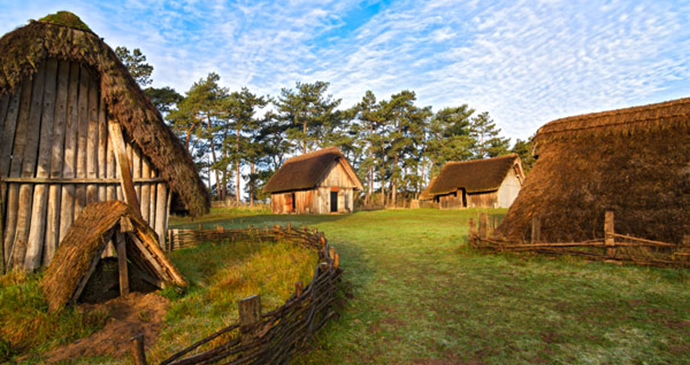
Several well-known writers are or have been based here too. Roger Deakin, who used to live in the village of Mellis just south of Diss, chronicled the changes of the season in Notes from Walnut Tree Farm and to a lesser extent in Wildwood, while nature writer Richard Mabey has more recently moved to the area and his Waveney Valley home features prominently in his book Nature Cure.
Louis ‘Captain Corelli’s Mandolin’ de Bernières has settled near Bungay, and W G Sebald in The Rings of Saturn, his meandering introspective walk through a rather sombre Suffolk, spent enough time in the Waveney Valley to be quite spectacularly rude about a small hotel in Harleston just over the Norfolk border.
It’s easy to get carried away of course. Like everywhere else, there’s an element of reactionary Nimbyism here on occasion – the greatest fears seemingly being the provision of caravan sites for travellers and windfarms – but overall, it’s pretty welcoming and lacking the selfsatisfaction sometimes found in more high-profile parts of the county. The key words here are probably ‘self-contained’ and ‘authentic’: real places with real shops serving real people.
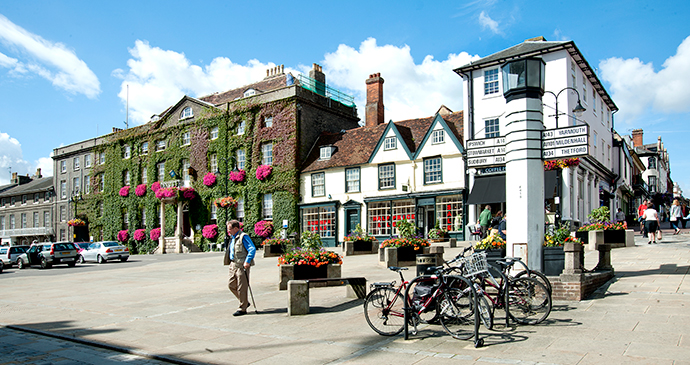
West Suffolk & The Brecks
These two regions are quite distinct: the Brecks, the arid, sandy heath and forest region that straddles the county boundary in the northwest of Suffolk, and the western region of the county that lies immediately south of this and has Bury St Edmunds at its centre.
Both regions have historical interest well beyond what one might expect. Thetford, the Brecks’s largest town, just over the border in Norfolk, was once home to the monarchs of East Anglia and the seat of a bishopric. Brandon nearby has long been a centre for flint mining, an industry that dates back to Neolithic times. Bury St Edmunds is a place apart, the capital and burial site of the Saxon King Edmund. The area south of Bury St Edmunds is home to some of Suffolk’s most enchanting countryside, a rural landscape of rolling farmland, sleepy tucked-away villages, narrow country lanes and high hedgerows – an area ripe for Slow exploration. Although focusing primarily on Suffolk, this chapter will occasionally make brief inroads into Norfolk in order to get a fuller understanding of what the Brecks region has to offer.
More information
For more information, see our guide to Suffolk:
Related articles
This East Anglia cycling route offers a classic cross section of the Suffolk coast, heath and countryside.
Boasting fascinating history, a rich array of architecture and quintessential English charm, this cobblestoned town is the perfect place to spend a weekend.
This circular walk explores a landscape that has attracted football stars and Impressionist painters alike.
Some people go to church, others go to churches.
Abundant in picturesque towns, magnificent country walks and a beautiful coastline, Suffolk has plenty of areas to explore.
Laurence Mitchell retraces John Constable’s steps on a walk through the Stour Valley.
This art of decorative plastering is a regular feature of buildings across Suffolk.
